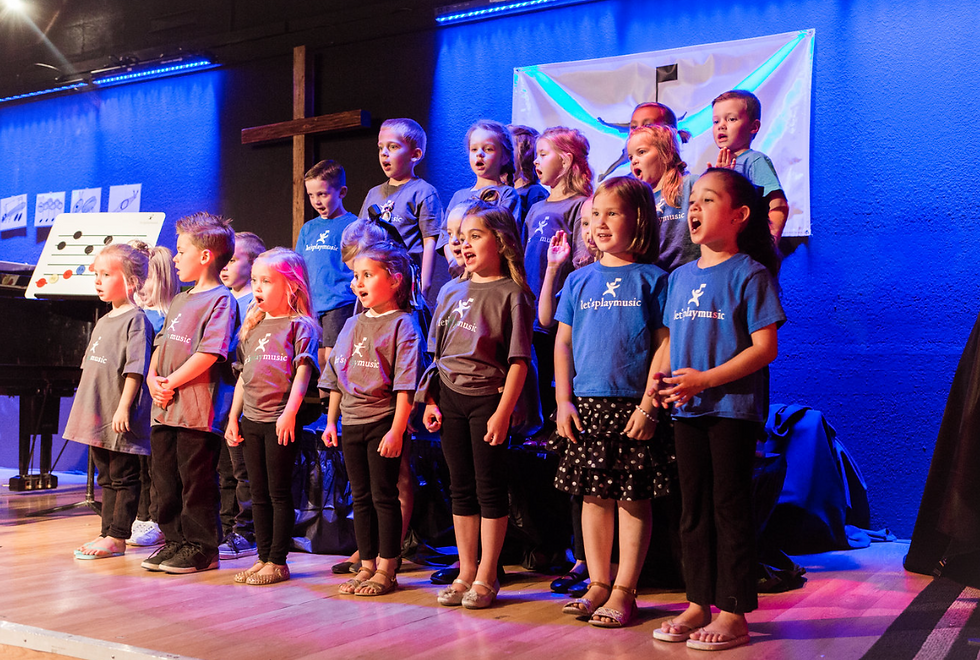
Is your son or daughter excited to perform some really great piano pieces in Let's Play Music? Excellent! Let's head to class and get started with some really great singing.
Wait, what!?
Why are we starting with singing? What does that have to do with playing an instrument?
Did You Hear That?
Let's consider your child's piano journey and the musician they'll become. Remember the scene from "The Music Man" where Amaryllis is having her piano lesson and her teacher continues to correct her last note? Ms. Marion had a sharp ear. She could hear the mistakes Amaryllis was making (audiating music). It frustrated her that Amaryllis played the same error without noticing.
Before your child starts on the keyboard, let's improve their ear. It's essential for effective music training--focusing on sound before symbols. Using the singing voice is crucial. It is a child's first instrument and foundational for ear training.
A child who plays an instrument before he sings may remain unmusical for a lifetime. That is why we encounter so many skillful pianists who have no idea of the essence of music. To be internalized, musical learning must begin with the child's own natural instrument...the voice. -- Zoltan Kodaly

Singing for the Song
Singing isn't just for aspiring piano or violin virtuosos. Children naturally love to imitate and create, finding joy in spontaneous, expressive singing. For instance, your child might happily sing while playing with play-doh, crafting a song about cutting play-doh cakes. By fostering a supportive environment, teachers and parents can encourage children to freely explore their voices both in class and at home. With practice, the voice can evolve into a beautiful and versatile instrument—let your child discover if it's their favorite!
Tip: Take great care to lovingly nurture singing. Avoid scolding a child for too much singing or singing too loudly. Just a few negative comments can make someone decide, "I'm not a good singer." While teaching your child social behavior is important, start by praising her singing. For instance, you can say "I love how passionately you're singing, but the piano tuner needs quiet to work. Can you take your song downstairs or hum until he's finished?"
Tip: Encourage spontaneous singing. When you catch a child singing to themselves, join in with a few bars and a nod, signaling it's normal and cool. If your child stops singing when you enter, be sure to say, "I was enjoying your song. It sounded like you were having fun."

How to Spark Spontaneous Singing
Here are a few things to try to get the ball rolling:
Tip: Find out how your child likes to sing. He might enjoy humming along to background music alone. Or he might prefer singing face-to-face for a deeper connection. Alternatively, he might feel more comfortable singing with the whole family, avoiding pressure on his solo voice. For example, one of your children might sings in the car, while another enjoys singing hand-in-hand as you walk.
Tip: Use resources. There are many resources available to help kids explore singing and music. Simply singing along with a beloved movie is one way to model joyful music making . Watching educational TV with your child—or at least listening while doing chores—and discussing it afterward makes it even more educational. If you're looking for educational TV, consider musical children's shows like "Bluey."
Tip: Simplify. Take the words out or slow them down. Mastering the melody and the lyrics are separate skills. It's helpful to focus on one at a time. Sing class songs slowly or with made-up consonants (like 'bum-bum-ba-dum'). In our classes, we simplify this with Echo Ed singing a few notes using 'loo-loo'. For a perfectionist child, singing a fast song can be daunting, as it risks making mistakes with notes or words.
Tip: Repetition, repetition, repetition. It takes repeated listens for a song to sink in. The brain learns to recognize patterns and understand music. Let your child listen to the same songs frequently before expecting them to sing along. Incorporate listening to your Let's Play Music album daily; use times like car rides or bedtime for official listening sessions. If you're present during these times, sing along to demonstrate that singing is a natural part of enjoyment.
Tip: Embrace silence. We all need some quiet time for our brains to process what we've been hearing. Allow your child ample quiet playtime. During the quiet, you will likely hear echoes of songs he's heard. This is when I hear the invented songs about play-doh and puzzles from my daughter.
Sing on Pitch
Perhaps now your child is comfortable singing at home and in class, but struggles to Echo Ed correctly and sing a recognizable tune.
Please tell us in the comments if you have had a reluctant singer and share how you got the songs going!
Comments